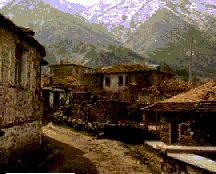Albanian language
Albanians are considered the descendants of ancient Illyrians
partly assimilated by Greeks and Romans. Else nobody knows where do they
come from, for Albanian has no close relatives in Europe.
 Two
major Albanian dialects have been developing in different ways for about
1000 years: Gheg, spoken in northern Albania, above the Shkumbin River;
and Tosk, found to the south of that river, as well as in the Italian and
Greek enclaves. The speakers of these dialects, for the most part, can
understand one another. A South Gheg dialect was used as the official language
of Albania from 1909 until World War II; thereafter, the official language
was based on Tosk. Written in Roman script, a limited amount of literature
exists in Albanian, most of it produced after the 19th-century national
revival.
Two
major Albanian dialects have been developing in different ways for about
1000 years: Gheg, spoken in northern Albania, above the Shkumbin River;
and Tosk, found to the south of that river, as well as in the Italian and
Greek enclaves. The speakers of these dialects, for the most part, can
understand one another. A South Gheg dialect was used as the official language
of Albania from 1909 until World War II; thereafter, the official language
was based on Tosk. Written in Roman script, a limited amount of literature
exists in Albanian, most of it produced after the 19th-century national
revival.
Albanian constitutes a separate branch of the Indo-European language
family. Its grammar is most similar to that of Modern Greek and Romanian.
The vocabulary includes many loanwords from Latin, Romanian, and especially
Turkish language. The phonetic system is quite peculiar for Indo-European,
it includes several sounds found nowhere else, and also the so-called "schwa"
which was developed late and is not Indo-European in its nature.
Albanian nouns have two genders (masculine and feminine), five cases
(including ablative, lost in all other European languages), definite and
indefinite articles are widely used. Practically all inflexions were lost,
and remaining ones dont remind Proto-Indo-European. The verb system is
quite complicated, having eight tenses (including two different futures
and two aorists), and several moods: indicative, imperative, conditional,
conjunctive, optative and admirative; active and passive voices are used.
In fact, Albanian is very interesting with its unique features and really
worth studying. Some time we will surely publish its grammar free online.
 Two
major Albanian dialects have been developing in different ways for about
1000 years: Gheg, spoken in northern Albania, above the Shkumbin River;
and Tosk, found to the south of that river, as well as in the Italian and
Greek enclaves. The speakers of these dialects, for the most part, can
understand one another. A South Gheg dialect was used as the official language
of Albania from 1909 until World War II; thereafter, the official language
was based on Tosk. Written in Roman script, a limited amount of literature
exists in Albanian, most of it produced after the 19th-century national
revival.
Two
major Albanian dialects have been developing in different ways for about
1000 years: Gheg, spoken in northern Albania, above the Shkumbin River;
and Tosk, found to the south of that river, as well as in the Italian and
Greek enclaves. The speakers of these dialects, for the most part, can
understand one another. A South Gheg dialect was used as the official language
of Albania from 1909 until World War II; thereafter, the official language
was based on Tosk. Written in Roman script, a limited amount of literature
exists in Albanian, most of it produced after the 19th-century national
revival.